An Overview And Interview Series With Alameda Residents Of Days We Tend To—Or Might Want To– Forget
Interviews Follow, Below The Overview
Text and Photos By Larry Freeman; Interviews by ANN Student Journalist Intern, Ben Rubin
(Editor’s note: In the interest of community public service, ANN is providing free access to this story. Please support our efforts to bring quality community news and public service to Alameda by becoming a paid subscriber, writer, photo journalist or news pod caster. Find out how on our homepage)

Four years ago, give or take a week or two, Alameda began to recognize and feel the cold grip of the rising Covid menace, which fanned the flames of deep seated, visceral fear as much as it imposed an advancing deep freeze on life as we, and most communities around the nation had known it.
That icy grasp eventually became a chokehold on socializing, business operations and access, school attendance, travel, recreation, family and interpersonal relationships and so much more.
Stricken with the fear of a constantly shifting, amorphous unknown, or little known menace, we altered behaviors, often erring on the anxiety driven side of extreme caution that came from being in the dark about the new plague’s means of transmission. Had we known that people get Covid mainly from close or longer term aeorosol viral loads in a person’s exhalations and rarely from hand surfaces, we might have gotten a small measure of solace. But such was not the case four years ago around this time.
Many masked up in their own cars to drive solo to those stores — especially providers of food, cleaning producs and medicine–where long lines with six foot social distancing markers on the pavement told us where to stand as the line moved slowly under conditions where only a handful of customers were allowed entry at any given time.
Isolation seemed to offer the only safe harbor. But sooner or later we had to venture out of that confine and mix with family, the general public, care givers, store clerks or friends.
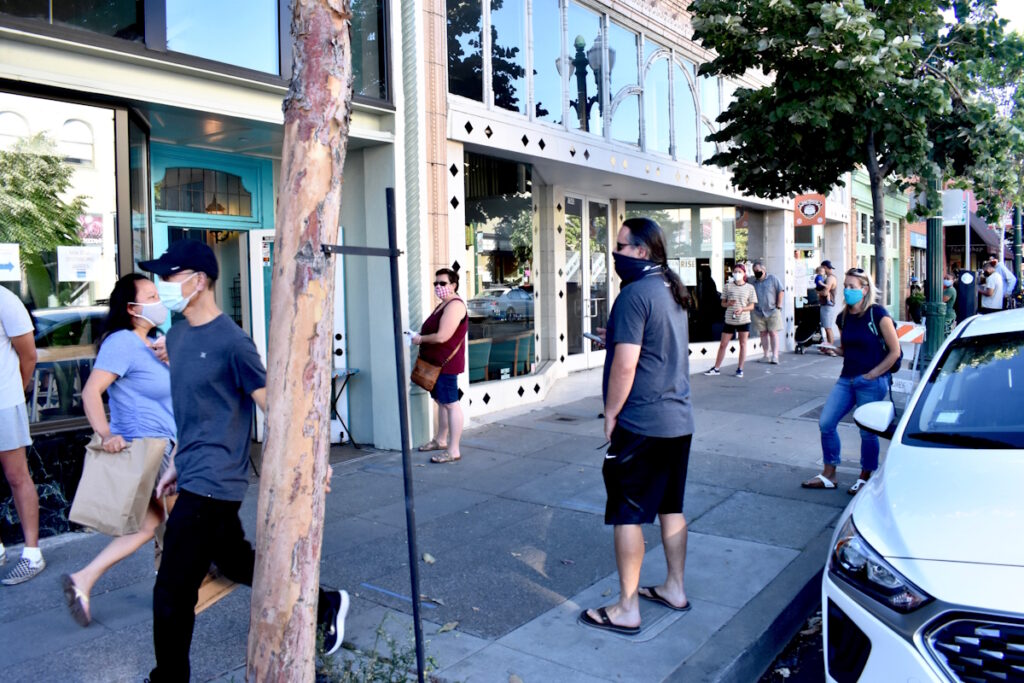
We raced nervously from store to store to find Clorox wipes, hand sanitizers, bleach bottles and more in hopes of preventing surface to surface transmission. Too often, we found shelves, racks, and cooler compartments devoid or depleted as uncertainty about supply chain deliveries added to the unpredictable environs of the outer world and our inner angst.
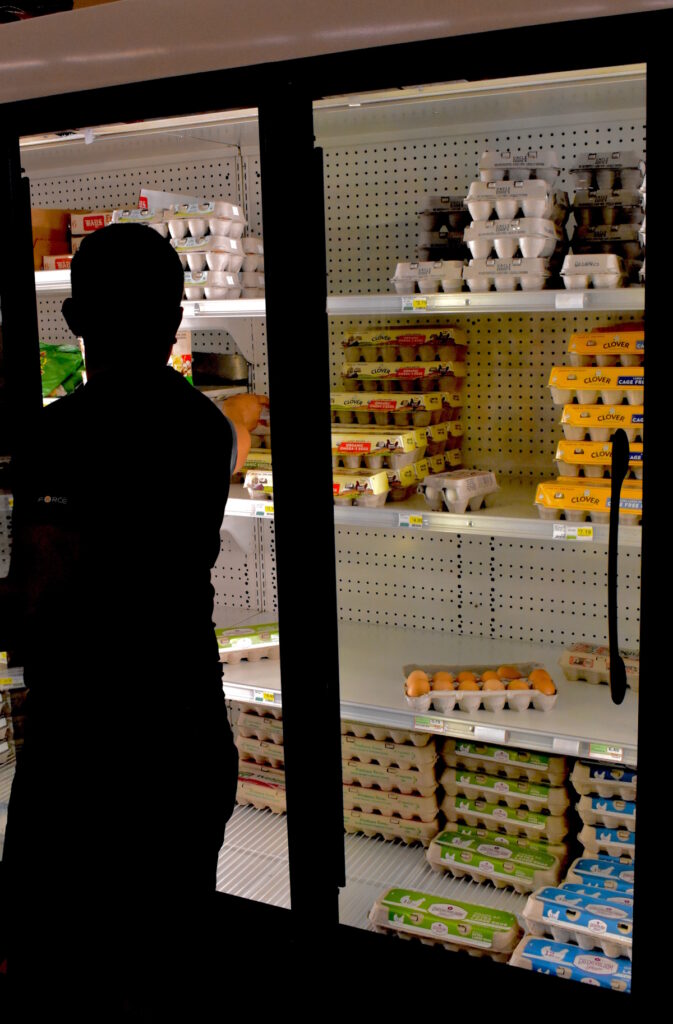
Scarcity and depletion confronted us, as store stocks dwindled or were utterly gone for untold periods of time as store personnel struggled to meet panic buying demand, as this shot at Encinal Market shows.
While frequent hand washing is an effective means of reducing viral infections from static surfaces, it was far less by that means that people get Covid than it is from breathing contaminated, close range or unrefreshed or machine purified air.
We looked and listened with chagrin, anxiety and disapproval at those whom we would hear cough, sneeze or sniffle, seeing them as toxic virus hives.
We lived in a ‘keep away from me/back up off me’ mindset and struggled as to what to do when we had relatives, spouses, children, friends and others who might unwittingly or uncaringly be walking around with a serious illness that, to confound matters, all too often shows no symptoms or took days to progress to where one even knew he or she was ill.
When test kits finally came on the market, they were far and few between for agonizingly slow passing months.
Kids and teachers floundered, trying to find ways to make school instruction, class attendance, and motivation work in what was euphemized as “distance learning,” or the more clinical moniker “remote instruction.”
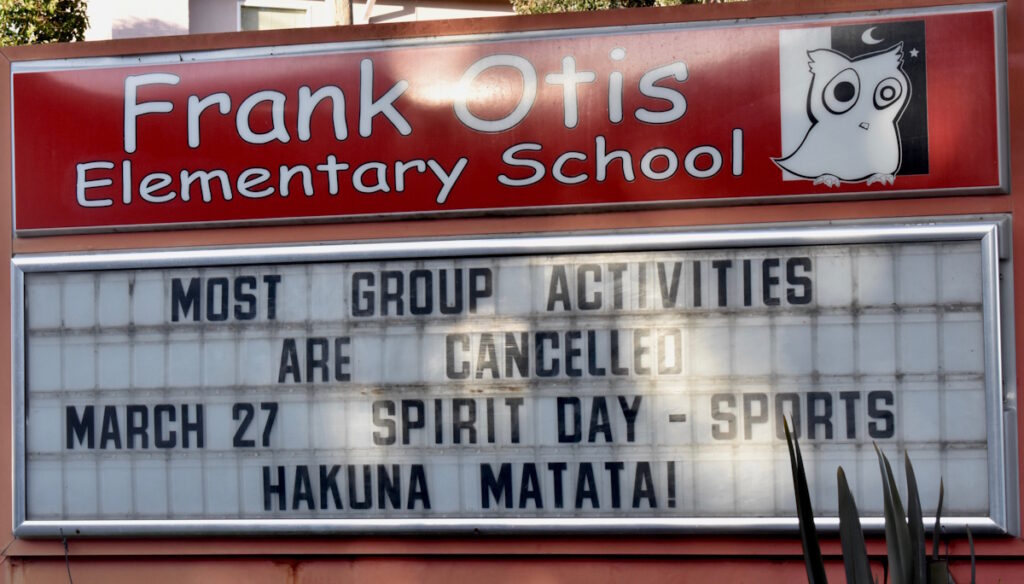
Anyway you cut it, and despite the best efforts of school administrations, classroom teachers, and even many parents, the system did not work well for far too many youngsters, and a so-called “learning deficit” began to mount.
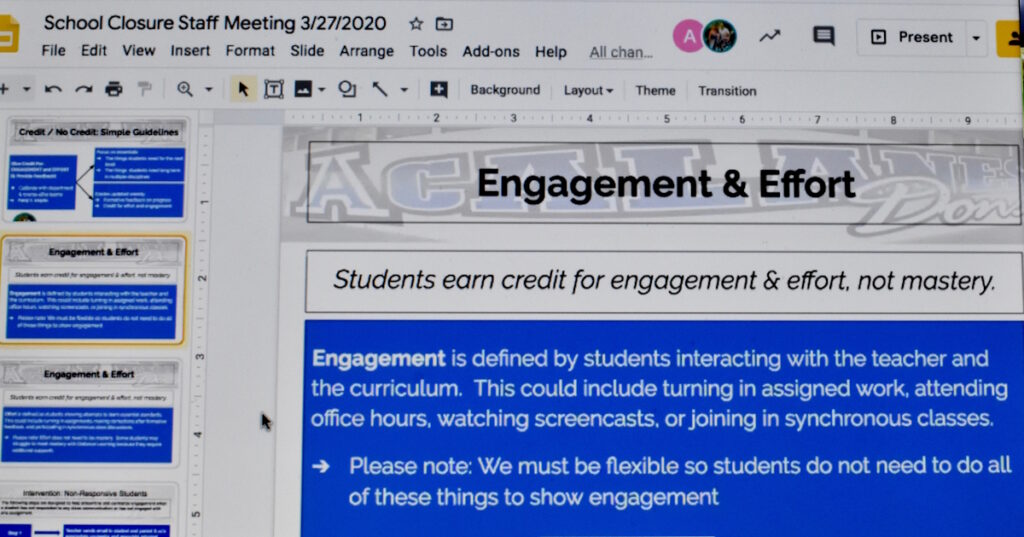
Eerie siites of suspended animation were our playgrounds, — silent and swathed in yellow caution tape, swings padlocked together, keep out and health warning signs forming a ‘no kid’s land’ perimeter. Places of play transformed into silent memorials of sorts, standing as mere, sad reminders of bygone childhood joys, and testaments to so much of what was lost.

The chains of swings met with chains and padlocks linked up and cinched to prevent use under the assumption that touching the play surfaces would speed the spread of the scourge.
Stuck in what seemed to be an overpowering spiral, with normalcy as we knew it spun by the wayside, we fixated on the cascade of the latest headlines and news reports that brought forth grim accounts of rising deaths and hospitalizations, as emergency rooms and intensive care units became packed, sometimes overwhelmed, with patients who, even after being on ventilators, might not come out alive.
We shuddered with dismay when we saw death rates soar around the world, nation and here in Alameda, week after week, month after month, and unabated for years to come.
Nine souls met their fate in March of 2020 in The Bay Area, and the number jumped to 79 to end the year. At that time, the very sickest, 478 persons, suffered from Covid in hospitals throughout Alameda County.
From March 3, 2020 through March 11th, we found that twenty three new cases hit Alameda County.
The next week the count rose to 103, followed by 224 the next week and by the end of that dark and daunting year we were adding over 5,000 new cases locally.
(That compares with just under 500 new Covid cases reported per week as of this time, still not a number to ignore Of those living in Alameda County, 11% have not had any Covid Vaccines administered at all, and only 29% of folks have had their boosters, which may account for the still sizeable number of new, Covid infected people at large)
We hoped against hope that somehow, someone somewhere would find medications or that a vaccine would come along to save the day, as the economy moved deeper and deeper into shutdown mode and we sank into recession, with many losing jobs and hope.
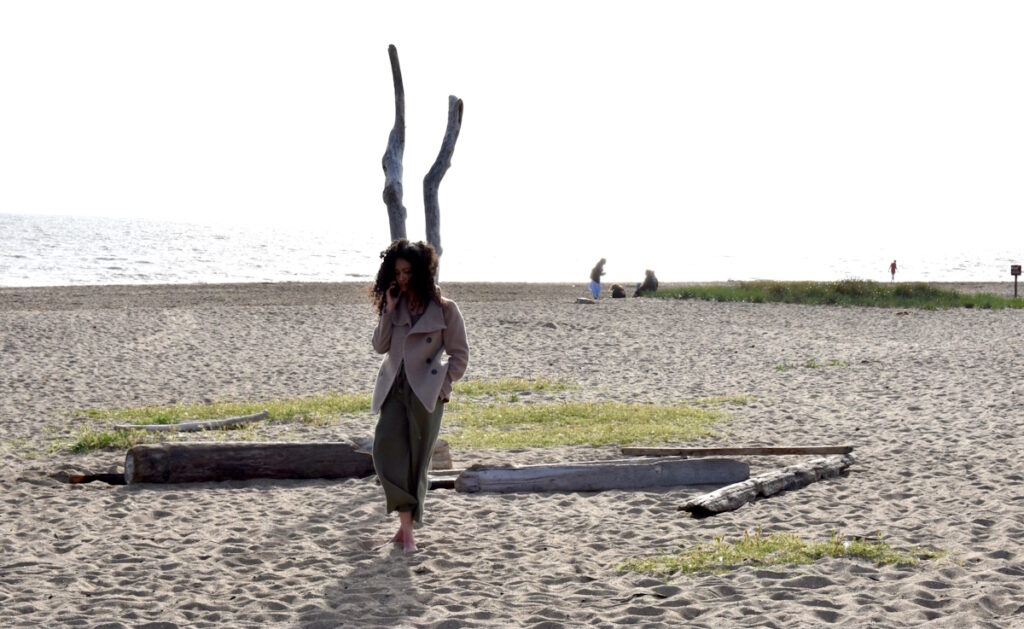
An early testing of hydroxychloriquine gave a false glimmer of hope, but proved to be of no therapeutic value according to NIH, The Mayo Clinic, The WHO and scores of other science-based medical research entities.
On March 17th, 2020 Moderna Pharmeceuticals began human trials for a vaccine which eventually proved to be an effective remedy, despite the roundly disproven opinions of so-called “Anti Vaxxers.”
On December 14, 2020, the first dose of The Covid Vaccine was administered in the U.S.. and locals got their first taste of very positive, hopeful news when we learned that the first round of 12.675 doses of Covid Vaccines –designated for health care workers and first responders– would arrive late that month, with more supply to follow.
“While we are still in the early phases, this is a hopeful moment for Alameda County residents,” Board of Supervisors President Richard Valle said in a public statement at the time. “A safe and effective vaccine will save lives and help residents and businesses return to some level of normalcy.”
The sad and sordid story is, of course much deeper, more detailed and wide ranging than is this brief account.
But at this time, four years later, it is of benefit to take a short look back on those dire times and how some locals recall them as we search within to acknowledge how far we have come, and to assess, perhaps, what we might have learned from the hardships of that ordeal, even though it is not fully behind us.
ALAMEDA RESIDENTS AND BUSINESS OWNERS SHARE THEIR THOUGHTS ON COVID CRIMPED DAYS
TALES OF COPING, LEARNING, MAKING DO OR SOMETIMES EVEN FINDING A SILVER LINING IN THE MIDST OF THE CLOISTERING, GRAY CLOUD
Interview Preview Takes:
Science “evolves. It does not stagnate, it doesn’t hold on to beliefs. It learns new things and changes its views. I feel like science led us where it led us for the best information we had at the time.” Joe Trimble, Owner, Encinal Market
“ I just wanted to stay around my parents who are older; I just wanted to stay around them and make sure they were safe and not put them in any harm’s way. – AJ Smith, Front Desk Employee at Bright Now! Dental
“ I was a Freshman in high school. We were most of the way through the year, and then everything was just suddenly super remote. That definitely took a toll on my mental health…. We played games together online. I picked up music. I started playing bass over Covid.” – Orla, Sandwich Board Employee
Interviews conducted, recorded and transcribed by Ben Rubin, ANN Journalism Student Intern
————————
“I’m a mom and my son was in sixth grade. He had just changed schools and hadn’t made friends yet at the new school so it was really sad because he had tried to make it work, so that was the hardest. On a positive note, my husband always commuted everyday to the city so we never got to have dinner together. During Covid, I enjoyed hanging out with him and eating dinner together and sometimes lunch together. So were one of those couples where the pandemic was really a good rebonding. We listened to a lot of records and had barbecues. It was harder for our son and maybe positive for my husband and I.
I was very fortunate that all my family got vaccinated and I didn’t personally lose a close family member. There were tragedies in my neighborhood though. So I would say my immediate family enjoyed some closeness. My neighborhood lost a few members and one or two went to the hospital for months and were on respirators, that was really scary. So I don’t want to paint it all rosy but I’m looking back and trying to look for the upside and that would be why I answered like that” – Larisa, Owner of Patina And Rust
“I was a senior in high school dealing with online school. I couldn’t really leave the house. It was weird y’know?
It was weird for me personally because I never experienced anything like that like having to stay home and having all those guidelines and stuff. It was interesting, I don’t know, I didn’t think we were gonna get past that but here we are.
It was hard to find jobs and stuff, school was especially hard though” – Sage, Cookie Bar Scoop Shop Employee
“When Covid started I was actually in Mexico and I was doing outreach as a grad student. It was really scary because I was in a different country so I didn’t know what was going on and everything and we were getting emails from our university saying classes are canceled and everything. And then when I came back the whole process was a little scary as well because everyone who was coming in internationally we were all in one big room, we were getting questionnaires and forms signed and all that stuff. We didn’t have masks or anything because at the time that wasn’t a thing. Yeah, it was a little scary.
I went outside a lot and went for walks. Tried to get outside in areas that weren’t dangerous I guess. I was in grad school so I dove into my work a little bit.” – Lea, Customer Service Associate at Park Centre Animal Hospital
“I was living here in Alameda. I didn’t know what it was, I wasn’t thinking about it, I had never heard about it before.
It (my life) didn’t change a whole lot cause I was still walking around. And when the shots- well I got the shots when they started getting those shots. I believed in them.
They told you to stay away from people, some people walked in the street, what did they say? ‘Stay six feet apart.’ It did change. It seemed kind of very restricting.
I would listen to music at home and read a little bit. I know I went to the library, we could still go to the library I think. Go to the park, oh we were doing Tai Chi out on the beach. You know Crown Beach? Because there you don’t have to get close to people. I did that.
They shut the movies down for awhile during all that , but when the movies were going on I went in there. You couldn’t sit close to people. I did stuff like that. What else? Y’know call people on the phone and stuff like that. Call my family in Jersey.” – Mel, Alameda Resident
“I was already living here in Alameda. I used to work in Oakland at the Dominoes on Broadway. What I remember the thing that changed the most was about my job. There were some restrictions. It wasn’t too bad actually. At my job the only thing that changed was we weren’t allowed customers in the lobby. So some people used to get angry at us because of that so that was the only tough part. And also when my brother got Covid he got it right at the beginning so that was very scary. I kept my family close, I came to church, and that really helped me.
My husband’s uncle, he’s the pastor. They were a great support for me, we’re really close. When my brother got sick it was good to have family around.” – Lilian Godoy, TL Church
“When the Covid happened I was not here. I was in Seattle. I had a Sizzler restaurant. Most of the time we were closed. State regulation or Federal regulation.
I was home, everyday walking. Watching TV. That was it.” – Raj, owner of Lola’s Chicken Shack
“When Covid started I was a Freshman in highschool, we were most of the way through the year and then everything was just suddenly super remote. That definitely took a toll on my mental health.
I would go on walks around my neighborhood just to get outside so I wasn’t totally shut in. I would text and call with my friends. We played games together online. I picked up music, I started playing bass over Covid.” – Orla, Sandwich Board Employee
“I stayed in California. I didn’t go anywhere.I stayed open. The business can stay open because people need it, you know?. People have to fix their showers, they have to buy the tile from my store so I opened the window during that time. People didn’t trust each other, so business went down, so I had to stay open to continue my business. I didn’t get any Covid at all.” – Calvin, Owner of Cal Tile Company
“I was here at the store when they announced the shut down – on the 16th of March I believe was the date. We had incredibly busy sales the weekend prior, the four or five days prior, you would have thought it was Armageddon hitting. The store was completely wiped out.
I just recently went back and looked at some pictures I took of the store and the dairy case was almost completely empty, the frozen was wiped out. We had lines stretching from the checkstand, through the produce department, all the way back to the frozen case. In my head I was thinking this could last two weeks, three weeks, a month, maybe two months at most and I thought we’d just do with it and be out of it, not knowing at all the science behind what would be happening and what we would be dealing with. It was a little bit terrifying, I was mostly concerned for the health and well being of the staff and the customers and the people in my life who deal with health complications.
(To cope) I think just trying to adhere to whatever the most current health standards were so whatever the health department was saying, wear masks dont wear masks, it was a bit of a yoyo trying to find ways to deal with it.
Health wise I think I started working out a lot more, I started working out an awful lot during the beginning of Covid for about the first six months or so, lifting weights and rowing, just trying to get some of the anxiety and stress out of my body.
I feel like science led us where it led us for the best information we had at the time. They said dont wear masks initially and then wear masks.
The science was evolving and I feel like that’s what science does. It evolves, it does not stagnate, it doesn’t hold on to beliefs , it learns new things and changes its views. Looking back I feel like that’s what science dictated and my views on it are that they did the best they could, given the information they had at each phase of the disease” – Joe Trimble, Owner of Encinal Market
“I was actually at work, I was at my other job at a car dealership in Hayward when it started, when everything got shut down. We all had to just be sent home and we didn’t know when we were going to get restarted. I just spent time with my family.
Ultimately, because I know, for a lot of people, it was tough having to be stuck inside. For me, I’ve always been more of a home body type, so it wasn’t much of an issue. I just wanted to stay around my parents who are older; I just wanted to stay around them and make sure they were safe and not put them in any harm’s way.
I wouldn’t say my perspectives changed. I’ve always been the type to air on the side of caution. Staying vigilant and trying to protect the people around me. I’ve always been the type to always try to stay healthy so nothing really changed outside of I know how it affected everybody in such a major way so it definitely showed me that you always have to try to stay safe as possible” – AJ Smith, Front Desk Employee at Bright Now! Dental
“I was living in San Bruno which is in the West Bay. I was going through a really tough time, not to get too personal but I was kicked out of the house and it was a really tough time because I had to move in with my girlfriend. I was jobless because I had moved. I was really trying to find another job but no jobs were even hiring. I was trying to apply to so many places, even things like McDonalds they wouldn’t even take me. Luckily, I found a job with Chipotle but it was really hard. After Covid got easier, I found another job through a friend. It got better from there of course.
I was super inside. My roommates would be working, even with the Covid regulations just because they had jobs, but I just didn’t have a job, and I couldn’t really go anywhere, so I just stayed inside. I was pretty much just terminally online for just a little bit. And then I started working again and then that kinda got me outside.
(My perspectives changed) a little bit for sure. I guess I would say, – I wouldn’t say depressed– but I kinda realized ‘damn,’ I miss going outside and talking to people. I just remember being at home and not really remembering what day it was. I just wake up and live and stuff. I’m kinda glad I’m going outside. That’s kinda where I’m at.” – Steven Eiserle, Employee At The Experience Share Video Games Store
“I was actually working at a gym when Covid started. We were told it was gonna last two weeks, that we’d be back in two weeks. I didn’t think of anything too much, I mean for everything to lock down I was pretty surprised. Other than that maybe it was just taking precaution, I didn’t think of it too much.
When I realized it was longer than two weeks I kinda just figured what am I gonna do, what can I do, just try to figure out how I’m gonna get back in the gym. Just trying to figure out my new daily life pretty much, just kinda staying home, playing video games, nothing really much.
(My perspectives changed) a little bit. Not really. For me I didn’t think of it too much. I just thought it was like a severe flu. I’ve never gotten it nor did I ever get the shots so I was kinda just ‘whatever’ about it.” – Alex, Employee At Island Exotics
TO THE READER: If you have Covid recollections to share please use the “Communicate!” button and click on the “Contact ANN” selection on the drop down menu. Please note that your answer is limited to 150 words. We will consider your submissions for addition to this story.
LOCAL PHOTOGRAPHERS: If you have photos that tell the story of Covid, please email them as attachments to Alamedaneighborhoodsnews@gmail.com and send them as jpeg (default) attachments. Limit of four per photographer. Please provide a caption or title for each photograph. We will consider your submissions for addition to this story.
AN UP AND COMING YOUTH REPORTER WHO MADE THESE INTERVIEWS COME TO LIFE:
ANN Student Intern, Ben Rubin, a local who is studying Journalism at San Francisco State University, took to the streets of Alameda during mid March, and compiled this set of in person interviews from folks around town. Ben is currently seeking and making progress towards his goal of becoming a Certified Content Contributor for ANN (for more information on how you can pursue that goal, see the “Journalism Free Education” section on our homepage.


Sometimes it took inner strength and the optimism of children to help buoy us, as these messages of inspiration and hope became a release of inner feelings through colorful chalk on hard, black asphalt.
(source: CDC Museum, Covid 19 Timeline by David J. Sencer)
January 31, 2020
CDC issues 14-day federal quarantine orders to all 195 U.S. citizens who were repatriated back to the U.S. on January 29, 2020, from Wuhan, China.
WHO’s International Health Regulation Emergency Committee reconvenes early to declare the 2019 Novel Coronavirus outbreak a Public Health Emergency of International Concern (PHEIC).
The Secretary of the Department of Health and Human Services (HHS), Alex Azar, declares the 2019 Novel Coronavirus (2019-nCoV) outbreak a public health emergenc
2/25 “the disruption of everyday life may be severe.” Dr Nancy Messonnier, CDC 2/25/2020
March 17, 2020
Moderna Therapeutics begin the first human trials of a vaccine to protect against COVID-19 at a research facility in Seattle, Washington.
March 19, 2020
California governor Gavin Newsom issues a statewide stay-at-home order to slow the spread of COVID-19 instructing residents to only leave their homes when necessary and shutting down all but essential businesses.
March 27, 2020
The Trump Administration signs the Coronavirus Aid, Relief, and Economic Security (CARES) Act into law. The act includes funding for $1,200 per adult (with expanded payments for families with children), expanded unemployment benefits, forgivable small business loans, loans to major industries and corporations, and expanded funding to state and local governments in response to the economic crisis caused by COVID-19.
March 31, 2020
At a White House Press Briefing, Dr. Anthony Fauci and Dr. Deborah Brix announce that between 100,000 and 240,000 deaths in the U.S. are expected— even if social distancing and public health measures are perfectly enacted.
April 10, 2020
With over 18,600 confirmed deaths and more than 500,000 confirmed cases in under four months, the U.S. is the country with the most reported COVID-19 cases and deaths, surpassing Italy and Spain as a global hot-spot for the virus.
April 20, 2020
As the COVID-19 pandemic grows, shortages of personal protective equipment (PPE) like gowns, eye shields, masks, and even body bags, become dire– particularly in New York
